Unwrapping the Packages | by Michael
Back in May, I offered a cursory preview of how Weis might use Irish personnel in different groupings or packages in his first season. Some potential formations were diagrammed, and some predictions were sheepishly made. (Where have you gone, Justin Hoskins?)
Could there be a better time than the Fiesta Bowl to return to the discussion? Weis has enjoyed five weeks to design and install a gameplan specific for the Buckeyes, and if you’ve been perusing the Notre Dame message boards, it's clear that some fans believe that he'll concoct something exotic, something unseen in 2005. Will that happen? Maybe, maybe not. Until we find out on Monday, though, let's familiarize ourselves with what the Irish offense has been doing, successfully and unsuccessfully, and just how often they’ve been doing it.
Using the same nomenclature from May, we charted the personnel grouping and outcome for each play (first team offense only) of every game. Sacks and scrambles were considered "designed passes," as were those swing passes and quick hitches that Quinn often threw. Here are the results.
| Package | % Used | Run % | Runs | Yards | YPR | Pass % | Passes | Comp | Comp% | Yards | YPA |
| Goal Line | 1.7 | 85.7 | 12 | 12 | 1 | 14.3 | 2 | 0 | 0 | 0 | 0 |
| Heavy | 19.4 | 42.4 | 67 | 330 | 4.9 | 57.6 | 91 | 49 | 58.3 | 615 | 7.3 |
| Jumbo | 7.4 | 76.7 | 46 | 173 | 3.8 | 23.3 | 14 | 6 | 50 | 87 | 7.3 |
| Lite | 35.2 | 30.8 | 88 | 433 | 4.9 | 69.2 | 198 | 176 | 68.8 | 1614 | 9.2 |
| Regular | 22.6 | 42.9 | 79 | 353 | 4.5 | 57.1 | 105 | 64 | 67.4 | 956 | 10.1 |
| Tight | 10.2 | 68.7 | 57 | 188 | 3.3 | 31.3 | 26 | 13 | 59.1 | 225 | 10.2 |
| Wides | 3.4 | 3.6 | 1 | 3 | 3 | 96.4 | 27 | 18 | 72 | 136 | 5.4 |
Let’s break it down a little further.
Lite, aka "Doubles"
 The Irish utilized a 3-WR package about 35% of the time and had success both throwing the ball and running the ball, although there was a heavy tilt toward airing it out (69%-31%). Brady Quinn's favorite receiver was Jeff Samardzija, who caught 31 of 46 pass attempts for 470 yards. Maurice Stovall was the primary deep target, as he averaged over 20 yards on his 25 catches. The middle of the field was open for Anthony Fasano, who snagged 22 of the 25 balls thrown to him and added 228 yards. Darius Walker made 21 catches out of the backfield, while Matt Shelton posted 18. The passing game was especially effective in setting up the run as Walker ran for 406 yards (an impressive 5.2 yards per carry).
The Irish utilized a 3-WR package about 35% of the time and had success both throwing the ball and running the ball, although there was a heavy tilt toward airing it out (69%-31%). Brady Quinn's favorite receiver was Jeff Samardzija, who caught 31 of 46 pass attempts for 470 yards. Maurice Stovall was the primary deep target, as he averaged over 20 yards on his 25 catches. The middle of the field was open for Anthony Fasano, who snagged 22 of the 25 balls thrown to him and added 228 yards. Darius Walker made 21 catches out of the backfield, while Matt Shelton posted 18. The passing game was especially effective in setting up the run as Walker ran for 406 yards (an impressive 5.2 yards per carry).Given the talented Buckeyes' linebackers, expect to see this package a lot. The Irish will need to spread the defense out, and this package is precisely how they’ve done that all year.
Regular
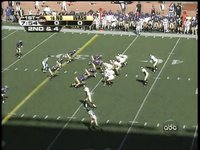 The second most popular (23%) personnel grouping sent Shelton to the bench and brought Asaph Schwapp onto the field for a traditional pro style offense. Despite the presence of an additional run blocker, Weis still preferred throwing the football by a landslide 57%-43% margin. Quinn arguably played his best with this surrounding cast as he completed 67% of his passes for over 10 yards per attempt. Samardizja became the deep threat (19 catches for 380 yards) while Stovall became the gritty possession receiver (16 for 240). Walker had the third most catches with 8, and it's likely that Rashan Powers-Neal would have easily surpassed that had he not been suspended. Through the first four games, he caught all 7 passes thrown in his direction for 74 yards. Meanwhile, Walker garnered 302 yards on the ground with a healthy 4.4 per carry average.
The second most popular (23%) personnel grouping sent Shelton to the bench and brought Asaph Schwapp onto the field for a traditional pro style offense. Despite the presence of an additional run blocker, Weis still preferred throwing the football by a landslide 57%-43% margin. Quinn arguably played his best with this surrounding cast as he completed 67% of his passes for over 10 yards per attempt. Samardizja became the deep threat (19 catches for 380 yards) while Stovall became the gritty possession receiver (16 for 240). Walker had the third most catches with 8, and it's likely that Rashan Powers-Neal would have easily surpassed that had he not been suspended. Through the first four games, he caught all 7 passes thrown in his direction for 74 yards. Meanwhile, Walker garnered 302 yards on the ground with a healthy 4.4 per carry average.Gotta wonder if we'll see this package less since playing the freshman Schwapp plays right into the strength of the Buckeyes' defense: those fast and physical LBs.
Heavy
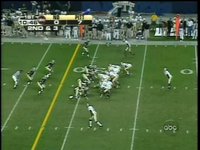 John Carlson was a big part of this 2-TE, 2-WR package, which Weis employed a little more than 19% of the time. Generally, when teams bring in a second TE, it means a commitment to running the ball...not so with the 2005 Irish. When Carlson and Fasano were both in the game, the Quinn threw the ball 58% of the time. As expected, though, the running game clicked with two TEs, and Walker averaged 5.2 yards per carry in accumulating 312 yards. Quinn put up modest numbers (completing “just” 58% of his passes for “only” 7.3 yards per attempt). Samardzija caught 16 passes for 232 yards, Stovall added 199 yards on 12 catches, and Fasano rounded out the triumvirate with 10 for 112 yards. Carlson was only thrown 6 passes all year, catching 2 of them.
John Carlson was a big part of this 2-TE, 2-WR package, which Weis employed a little more than 19% of the time. Generally, when teams bring in a second TE, it means a commitment to running the ball...not so with the 2005 Irish. When Carlson and Fasano were both in the game, the Quinn threw the ball 58% of the time. As expected, though, the running game clicked with two TEs, and Walker averaged 5.2 yards per carry in accumulating 312 yards. Quinn put up modest numbers (completing “just” 58% of his passes for “only” 7.3 yards per attempt). Samardzija caught 16 passes for 232 yards, Stovall added 199 yards on 12 catches, and Fasano rounded out the triumvirate with 10 for 112 yards. Carlson was only thrown 6 passes all year, catching 2 of them.Notre Dame will need to run the ball at some point, and they've done it best using this formation. It'd be prototypical Weis to throw Ohio State a curveball by lining up his TEs wider than he's done all year and by incorporating motion to get some favorable match-ups. Fasano has demonstrated his ability to get open all year, and Carlson's speed could be a wild card, although he has had the "drops" at times this year. Also, what better way to test Bobby Carpenter’s health and Anthony Schlegel’s athleticism than by asking them to cover TEs?
Tight
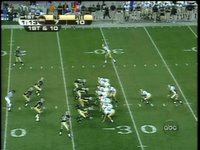 As the season wore on, Travis Thomas found a permanent home in this grouping, which Weis used 10% of the time. Earlier in the season it was Powers-Neal, but now when Carlson and Fasano are joined by Schwapp, it's Thomas who lines up behind them…and the substitution has worked like a charm. Thomas picked up 4.3 yards per carry (23 for 97 yards), while Walker (3.1), Powers-Neal (3.0), and Schwapp (2.0) all struggled. Additionally, Quinn hit some deep passes off play action. About half the time that you see him fake the hand-off, Samardzija is usually getting open downfield (6 grabs for 127 yards). Carlson and Fasano also added 2 and 3 catches, respectively, for a combined 65 yards.
As the season wore on, Travis Thomas found a permanent home in this grouping, which Weis used 10% of the time. Earlier in the season it was Powers-Neal, but now when Carlson and Fasano are joined by Schwapp, it's Thomas who lines up behind them…and the substitution has worked like a charm. Thomas picked up 4.3 yards per carry (23 for 97 yards), while Walker (3.1), Powers-Neal (3.0), and Schwapp (2.0) all struggled. Additionally, Quinn hit some deep passes off play action. About half the time that you see him fake the hand-off, Samardzija is usually getting open downfield (6 grabs for 127 yards). Carlson and Fasano also added 2 and 3 catches, respectively, for a combined 65 yards.The Irish ran the ball 69% of the time when these players were on the field, and it’s the preferred package in short yardage situations. The $64,000 question might be, is this package where Weis might get creative with his red zone playcalling?
Jumbo
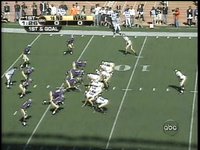 Another 7% of the time Schwapp was removed from the Tight package in favor of a third TE. The Irish ran the ball nearly 77% of the time in Jumbo, but averaged only 3.8 yards per carry. Quinn completed only 50% of his passes, and of the four targets on the field, he only passed to Samardzija and Fasano. Nearly one-third of this grouping’s plays occurred against Washington and Southern Cal (and the Irish ran every time against the Trojans), but it wasn't used at all against Tennessee, whose defense has been compared to the Buckeyes’.
Another 7% of the time Schwapp was removed from the Tight package in favor of a third TE. The Irish ran the ball nearly 77% of the time in Jumbo, but averaged only 3.8 yards per carry. Quinn completed only 50% of his passes, and of the four targets on the field, he only passed to Samardzija and Fasano. Nearly one-third of this grouping’s plays occurred against Washington and Southern Cal (and the Irish ran every time against the Trojans), but it wasn't used at all against Tennessee, whose defense has been compared to the Buckeyes’.Will Weis treat the Buckeyes' front seven with the same reverence he showed the Vols? It's definitely possible.
Wides
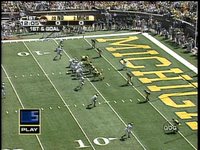 Maybe next year. Believe it or not, Weis has only utilized 4- or 5-WR sets 28 times this year, and 21 of those came against the CB-impaired BYU. Of course, had Rhema McKnight not been lost for the season against Michigan, this package may have been utilized more by Weis. Then again, with 5 weeks to prep, maybe David Grimes is ready to join Samardzija, Stovall, Fasano, and Shelton in prime time.
Maybe next year. Believe it or not, Weis has only utilized 4- or 5-WR sets 28 times this year, and 21 of those came against the CB-impaired BYU. Of course, had Rhema McKnight not been lost for the season against Michigan, this package may have been utilized more by Weis. Then again, with 5 weeks to prep, maybe David Grimes is ready to join Samardzija, Stovall, Fasano, and Shelton in prime time.Although it's a popular opinion that Quinn will come out firing against Ohio State with empty and 1-back sets, it's likely that those packages will still include Walker and Fasano. They're simply too valuable to keep off the field as both blockers and receivers.
Goal Line
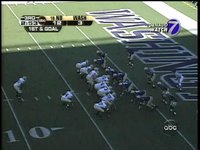 On 12 carries, the Irish running game picked up just 12 yards. At first that wouldn't appear to reflect a productive ground game but the Irish actually converted most of these short yardage situations. Despite the mediocre averages, hey eventually picked up the first down or touchdown on 7 of the 9 opportunities, although it took four tries against Purdue. The two non-conversions? First, Schwapp's fumble on first down against Michigan State, and then Tennessee's double stuffing, which included a sack. This package hasn't been pretty, but it's been fairly effective.
On 12 carries, the Irish running game picked up just 12 yards. At first that wouldn't appear to reflect a productive ground game but the Irish actually converted most of these short yardage situations. Despite the mediocre averages, hey eventually picked up the first down or touchdown on 7 of the 9 opportunities, although it took four tries against Purdue. The two non-conversions? First, Schwapp's fumble on first down against Michigan State, and then Tennessee's double stuffing, which included a sack. This package hasn't been pretty, but it's been fairly effective.Although this package was only used 14 times, it could be a factor in Tempe. I've got dibs on "Play action pass to Marcus Freeman."
Given my prescience for how Hoskins would be used in 2005, I wouldn't make a last minute trek to Vegas to make that prop bet. But then again, with Charlie Weis, you never know. Regardless, I’ll be back in a few days to compare the Fiesta Bowl game to the tendencies in the chart above. In other words, no reason to forsake that beer and bag of chips for pencil and paper.
However, before you grab the Doritos, er, Tostitos and salsa, here’s one last number worth mentioning...60%. That's the completion percentage of opposing quarterbacks against the vaunted Ohio State defense. Couple that number with the data above and, tell me again, why are the Buckeyes going to throttle the Irish on Monday? I just can't see it. The Irish have the ideal offense to attack the Buckeyes.
Irish 34, Buckeyes 27